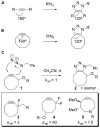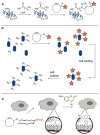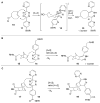Cu-free click cycloaddition reactions in chemical biology
- PMID: 20349533
- PMCID: PMC2865253
- DOI: 10.1039/b901970g
Cu-free click cycloaddition reactions in chemical biology
Abstract
Bioorthogonal chemical reactions are paving the way for new innovations in biology. These reactions possess extreme selectivity and biocompatibility, such that their participating reagents can form covalent bonds within richly functionalized biological systems--in some cases, living organisms. This tutorial review will summarize the history of this emerging field, as well as recent progress in the development and application of bioorthogonal copper-free click cycloaddition reactions.
Figures



















Similar articles
-
From mechanism to mouse: a tale of two bioorthogonal reactions.Acc Chem Res. 2011 Sep 20;44(9):666-76. doi: 10.1021/ar200148z. Epub 2011 Aug 15. Acc Chem Res. 2011. PMID: 21838330 Free PMC article.
-
Click chemistry reactions in medicinal chemistry: applications of the 1,3-dipolar cycloaddition between azides and alkynes.Med Res Rev. 2008 Mar;28(2):278-308. doi: 10.1002/med.20107. Med Res Rev. 2008. PMID: 17763363 Review.
-
Antibody functionalization with a dual reactive hydrazide/click crosslinker.Anal Biochem. 2013 Apr 1;435(1):68-73. doi: 10.1016/j.ab.2012.12.018. Epub 2013 Jan 8. Anal Biochem. 2013. PMID: 23313755
-
Optimizing the selectivity of DIFO-based reagents for intracellular bioorthogonal applications.Carbohydr Res. 2013 Aug 9;377:18-27. doi: 10.1016/j.carres.2013.05.014. Epub 2013 May 28. Carbohydr Res. 2013. PMID: 23770695 Free PMC article.
-
Development and Applications of the Copper-Catalyzed Azide-Alkyne Cycloaddition (CuAAC) as a Bioorthogonal Reaction.Molecules. 2016 Oct 24;21(10):1393. doi: 10.3390/molecules21101393. Molecules. 2016. PMID: 27783053 Free PMC article. Review.
Cited by
-
Designing degradable hydrogels for orthogonal control of cell microenvironments.Chem Soc Rev. 2013 Sep 7;42(17):7335-72. doi: 10.1039/c3cs60040h. Epub 2013 Apr 22. Chem Soc Rev. 2013. PMID: 23609001 Free PMC article. Review.
-
Metabolic Incorporation of Azido-Sugars into LPS to Enable Live-Cell Fluorescence Imaging.Methods Mol Biol. 2022;2548:267-278. doi: 10.1007/978-1-0716-2581-1_16. Methods Mol Biol. 2022. PMID: 36151503
-
Secretome protein enrichment identifies physiological BACE1 protease substrates in neurons.EMBO J. 2012 Jun 22;31(14):3157-68. doi: 10.1038/emboj.2012.173. EMBO J. 2012. PMID: 22728825 Free PMC article.
-
Tri-functional platform for construction of modular antibody fragments for in vivo 18F-PET or NIRF molecular imaging.Chem Sci. 2020 Jan 7;11(7):1832-1838. doi: 10.1039/c9sc05007h. Chem Sci. 2020. PMID: 34123276 Free PMC article.
-
Click-to-Chelate: development of technetium and rhenium-tricarbonyl labeled radiopharmaceuticals.Molecules. 2013 Mar 12;18(3):3206-26. doi: 10.3390/molecules18033206. Molecules. 2013. PMID: 23481882 Free PMC article. Review.
References
-
- Rostovtsev VV, Green LG, Fokin VV, Sharpless KB. Angew Chem, Int Ed. 2002;41:2596–2599. - PubMed
-
- Tornøe CW, Christensen C, Meldal M. J Org Chem. 2002;67:3057–3064. - PubMed
-
-
For a recent review see: Tornøe CW, Meldal M. Chem Rev. 2008;108:2952–3015.
-
-
-
For a recent review see: Sletten EM, Bertozzi CR. Angew Chem, Int Ed. 2009;48:6974–6998.
-
-
- Gaetke LM, Chow CK. Toxicology. 2003;189:147–163. - PubMed
Publication types
MeSH terms
Substances
Grants and funding
LinkOut - more resources
Full Text Sources
Other Literature Sources

